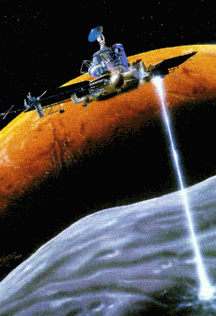
The Phobos 2 mission was launched on 12 July 1988 from
Baykonur Cosmodrome. The primary objective of the mission, as with its sister
probe Phobos 1, was to explore the larger of Mars' two moons, Phobos. In
addition to instrumentation to explore the Martian satellites, Phobos 2 also
carried instruments to study the Sun, Mars, the interplanetary medium, and
gamma-ray burst sources.
The Phobos 2 spacecraft arrived at Mars on 30 January 1989, but was lost
while maneuvering in Martian orbit to encounter Phobos on 27 March 1989. The
loss was traced to either a failure of the on-board computer or of the radio
transmitter (which was already operating on the backup power system).
Originally, both Phobos spacecraft were to carry identical instrument
payloads. Mass limitations required some tradeoffs so that certain instruments
were carried by only one spacecraft. Phobos 2 carried a total of 25
instruments. Of those, a few were high energy detectors. A diagram of the
Phobos instrumentation is included in the
Phobos images page.
- APEX Gamma-ray emission spectrometer.
- LILAS Low-energy gamma-ray burst detector.
- RF-15 X-ray spectrometer.
- VGS High-energy gamma-ray burst detector.
Due to the loss of the spacecraft, much of the original science objectives
were not met. However, the two months of data which were obtained did yield a
number of important results. These are summarized in
Goldman (1990).